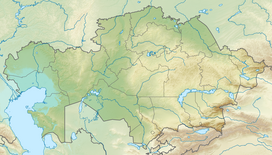Kokshetau Mountains
| Kokshetau Mountains | |
|---|---|
| Көкшетау тауы | |
 Landscape of the massif | |
| Highest point | |
| Peak | Mount Kokshe |
| Elevation | 970 m (3,180 ft) |
| Coordinates | 53°04′48″N 70°11′18″E / 53.08000°N 70.18833°E |
| Dimensions | |
| Length | 20 km (12 mi) N / S |
| Width | 5 km (3.1 mi) E / W |
| Geography | |
Location in Kazakhstan | |
| Location | Kazakhstan |
| Range coordinates | 53°00′N 70°21′E / 53.000°N 70.350°E |
| Parent range | Kazakh Uplands |
| Geology | |
| Orogeny | Alpine orogeny |
| Rock age(s) | Devonian and Silurian |
| Rock type | Granite |
Kokshetau Mountains (Kazakh: Көкшетау тауы) or Kokshetau Massif is a mountain massif in the Akmola Region, Kazakhstan.[1]
Shchuchinsk city and Burabay spa town are located in the massif. The mountains are part of the Burabay National Park, a protected area.[2][3]
Geography
[edit]The Kokshetau Mountains are part of the Kokshetau Hills, a subsystem of the Kazakh Uplands (Saryarka). It is a small, compact mountainous cluster of moderate altitude located in the northern sector of the highlands. Small lakes lie in the central, western and northwestern area of the range, including Burabay, Shchuchye, Ulken Shabakty and Kishi Shabakty.[2][3]
The highest point of the massif is Mount Kokshe, towering at 947 meters (3,107 ft) and located in the northern part near Kishi Shabakty Lake. River Kylshakty has its sources in the Kokshetau Massif. The slopes are often cut by deep ravines. Owing to denudation and weathering of the mountains there are bizarre-shaped rocky outcrops. Some of these rock formations display horizontal layers of eroded granite stone and look like ruined towers.[1][2]
 |
 |
Flora
[edit]The mountain slopes have forests of pine, birch, poplar, except for the rocky tops. There are also some areas of shrub growth. In the valleys at the foot of the mountains there are meadows of wheatgrass, couch grass and bromes, among other grass types. Steppe vegetation is present in the plains surrounding the massif.[1]
See also
[edit]References
[edit]- ^ a b c Nature of Kazakhstan: Encyclopedia / General editor. B. O. Jacob. - Almaty: "Kazakh Encyclopedia" LLP, 2011. T.Z. - 304 pages. ISBN 9965-893-64-0 (T.Z.), ISBN 9965-893-19-5
- ^ a b c Google Earth
- ^ a b "N-42 Chart (in Russian)". Retrieved 1 November 2022.
External links
[edit] Media related to Kokshetau Massif at Wikimedia Commons
Media related to Kokshetau Massif at Wikimedia Commons- Burabay National Natural Park
- Traveling in Burabay National Park

